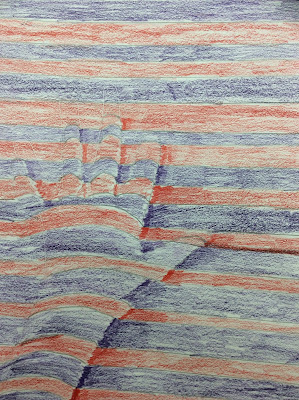If there is one subject near and dear to me other than art, it would have to be math. Our world is filled with math, and getting a good grip on it makes your artwork even cooler. Just ask these artists, who popularized optical illusions in fine art.
 |
| 26th July 1979: Bridget Riley, British Painter (Photo by Evening Standard) |
 |
| Victor Vasserly, c.1978 (Getty Images) |
Optical illusions are what happens when your eye perceives something that is different than reality. The effects that Riley and Vasserly achieved on flat surfaces are nothing short of mind-blowing. Students love optical illusions, perceived space, and implied shadow, and by fourth and fifth grade are itching to figure out how it is done.
Math, my dear, math. And some great shading skills.
Going backwards in time a bit, you may know the artist M.C. Escher.
 |
| Ascending and Descending, Lithograph, 1960 |
Born in 1898, Escher was said to be a crummy student, and spent a lot of time home sick as well. His dad was an engineer, but M.C. Escher eventually went to school for decorative arts, and shortly later discovered that his artwork was made much, much better with math. So, he spent more time as an adult investigating mathematics journals, and incorporating the concepts and discoveries into his artwork, notably in his tessellations and architectural renderings. His work is revered by scientists and mathematicians around the world, and is widely sought-after by collectors.
I love this story, because it so neatly describes how an unsure person can come to love math through art, and potentially vice-versa; if you love math, maybe this is your road to enjoy art-making. Here is some of the student artwork from EES:
 |
| Wow, right?! These kids... |
My math goal for this year involves having students gain comfort in using rulers for measurement. These are grade five projects, which began with a grid, and students were able to choose their spacing. Students who felt less confident might have chosen whole inches, whereas students looking for a greater math challenge chose fractions of inches as their spacing measure.
There were no rules around having to color in a grid specifically, or having to stick to the same two colors the whole way through, so the results were varied and beautiful.
The cast shadows really helped students feel that their work was "popping out" as they intended.
To make the cast shadows, students were asked to imply a light source consistently throughout the image, and also to apply that light source to the sphere itself.
Their work is pretty wonderful. One way to gauge that they love it is the time they are voluntarily filling their sketchbooks with more spheres, and that classroom teachers and parents are seeing these as well.
Fourth graders also used math tools, light, and shadow to create optical effects. Here is a sampling of their amazing work:
 |
| Fourth grade. |
 |
| Don't you love this triangular composition? |
Look for these in the halls around school. A display of their work is coming soon!


















Complements to the instructor!
ReplyDelete-Nick